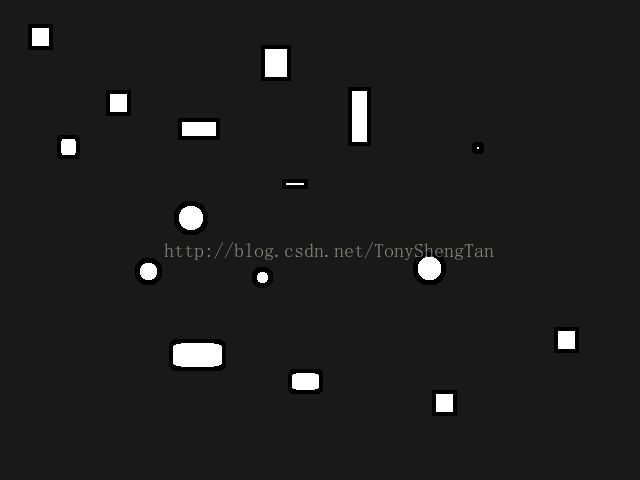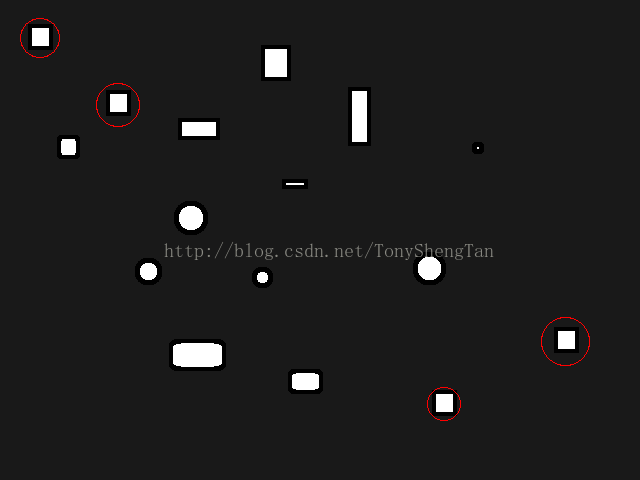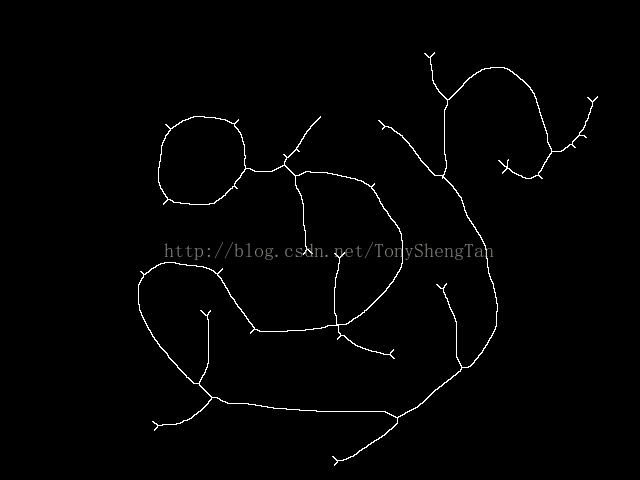Keywords: 二值图像,形态学,击中,边界提取,孔洞填充,连通分量提取,凸壳,细化,骨架,形态学重建
本文最初发表于csdn,于2018年2月17日迁移至此
开篇废话
其实写博客是个很痛苦的过程,要准备一些东西,还怕写错会误导别人,但是在总结和准备相关资料的时候会更深入的理解其中的一些算法原理,然后再根据自己的实际操作把过程表述出来,可以发现一些错误,也能理顺思路。 我百度找资料的时候(大牛都用google你怎么还用百度?我找不到上Google的方法
填充后结果
- 连通分量提取:与孔洞填充类似,孔洞处理的是被连通分量包围的背景,连通分量提取是提取的连通分量,而非中间的孔洞。所以从公式上看也非常相似。连通分量提取也需要种子点,所以也不是很智能。
四个连通分量,红点为示例种子点
凸壳:是为了找到一个凹陷的物体外壳,以不完美命中(腐蚀)为主要操作,通过调整结构元,加上原图,得到相关结果。
原图
凸壳添加结果
添加的凸壳
细化:细化和骨架有点类似,但涉及到一个是否同伦操作,来贴一下同伦的含义,拓扑学的一个概念,是连通性的一个概念定义,如果变换不改变连通结构,则视为同伦,或者同伦树不变,以下来自百度百科对同伦的解释,wiki的数学有点复杂,不好理解:
这个解释的很形象,尤其是终结者的实例,很形象。
上图:
原图放大好多倍以后,每个方框是一个像素
结果
- 骨架:使用形态学腐蚀减去结果的开运算的骨架与细化相比,缺少的就是同伦性,即骨架操作得到的并不是原图像的同伦变换,而且这种骨架有些地方并不是一个像素,而是多个像素,使得这种骨架算法应用不是很广泛,但骨架却应用相当广泛
- 形态学重建:提取原始图像中包含某些特定特征的连通区域,需要一个模板和一些种子点,比如重建开操作提取文字中有长竖“I”这种结构的,先用长竖对图像进行几次腐蚀(命中),使之得到一些点,在膨胀这些点,并以原图作为模板,最终得到包含长竖的字母。
代码
|
1
2
3
4
5
6
7
8
9
10
11
12
13
14
15
16
17
18
19
20
21
22
23
24
25
26
27
28
29
30
31
32
33
34
35
36
37
38
39
40
41
42
43
44
45
46
47
48
49
50
51
52
53
54
55
56
57
58
59
60
61
62
63
64
65
66
67
68
69
70
71
72
73
74
75
76
77
78
79
80
81
82
83
84
85
86
87
88
89
90
91
92
93
94
95
96
97
98
99
100
101
102
103
104
105
106
107
108
109
110
111
112
113
114
115
116
117
118
119
120
121
122
123
124
125
126
127
128
129
130
131
132
133
134
135
136
137
138
139
140
141
142
143
144
145
146
147
148
149
150
151
152
153
154
155
156
157
158
159
160
161
162
163
164
165
166
167
168
169
170
171
172
173
174
175
176
177
178
179
180
181
182
183
184
185
186
187
188
189
190
191
192
193
194
195
196
197
198
199
200
201
202
203
204
205
206
207
208
209
210
211
212
213
214
215
216
217
218
219
220
221
222
223
224
225
226
227
228
229
230
231
232
233
234
235
236
237
238
239
240
241
242
243
244
245
246
247
248
249
250
251
252
253
254
255
256
257
258
259
260
261
262
263
264
265
266
267
268
269
270
271
272
273
274
275
276
277
278
279
280
281
282
283
284
285
286
287
288
289
290
291
292
293
294
295
296
297
298
299
300
301
302
303
304
305
306
307
308
309
310
311
312
313
314
315
316
317
318
319
320
321
322
323
324
325
326
327
328
329
330
331
332
333
334
335
336
337
338
339
340
341
342
343
344
345
346
347
348
349
350
351
352
353
354
355
356
357
358
359
360
361
362
363
364
365
366
367
368
369
370
371
372
373
374
375
376
377
378
379
380
381
382
383
384
385
386
387
388
389
390
391
392
393
394
395
396
397
398
399
400
401
402
403
404
405
406
407
408
409
410
411
412
413
414
415
416
417
418
419
420
421
422
423
424
425
426
427
428
429
430
431
432
433
434
435
436
437
438
439
440
441
442
443
444
445
446
447
448
449
450
451
452
453
454
455
456
457
458
459
460
461
462
463
464
465
466
467
468
469
470
471
472
473
474
475
476
477
478
479
480
481
482
483
484
485
486
487
488
489
490
491
492
493
494
495
496
497
498
499
500
501
502
503
504
505
506
507
508
509
510
511
512
513
514
515
516
517
518
519
520
521
522
523
524
525
526
527
528
529
530
531
532
533
534
535
536
537
538
539
540
541
542
543
544
545
546
547
548
549
550
551
552
553
554
555
556
557
558
559
560
561
562
563
564
565
566
567
568
569
570
|
typedef
int DataType;
struct Position_{
int x;
int y;
};
typedef
struct Position_ Position;
typedef
struct Position_ MoveDirection;
//位移操作,将图像整体移动,如果超出边界舍去
int isEqual(IplImage *src1,IplImage *src2){
if(!isSIZEEQU(src1, src2))
return
0;
int width=src1->width;
int height=src1->height;
for(
int i=
0;i
for(
int j=
0;j
int v0=cvGetReal2D(src1, j, i);
int v1=cvGetReal2D(src2, j, i);
if(v0!=v1)
return
0;
}
return
1;
}
//检测图像是否为空
int isEmpty(IplImage *src){
int width=src->width;
int height=src->height;
for(
int i=
0;i
for(
int j=
0;j
int v=cvGetReal2D(src, j, i);
if(v!=
0.0)
return
0;
}
return
1;
}
void Translation(IplImage *src,IplImage *dst,MoveDirection *direction){
int width=src->width;
int height=src->height;
//printf("%d,%d\n",direction->x,direction->y);
IplImage *temp=cvCreateImage(cvSize(width, height), src->depth, src->nChannels);
cvZero(temp);
for(
int i=
0;i
for(
int j=
0;j
if(j+direction->y
i+direction->x
j+direction->y>=
0 &&
i+direction->x>=
0 )
cvSetReal2D(temp, j+direction->y, i+direction->x, cvGetReal2D(src, j, i));
}
cvCopy(temp, dst,
NULL);
cvReleaseImage(&temp);
}
//将小的图像弄到大的黑色图像中间,或者说是给图像加黑色边框
void Zoom(IplImage *src,IplImage *dst){
if(dst->width
dst->height
(dst->height-src->height)%
2==
1||
(dst->width-src->width)%
2==
1){
if(dst->width
printf(
"Zoom wrong:dst's width too small!\n");
if(dst->height
printf(
"Zoom wrong:dst's height too small!\n");
if((dst->height-src->height)%
2==
1||(dst->width-src->width)%
2==
1)
printf(
"Zoom wrong:dst-src not a oushu!\n");
exit(
0);
}
MoveDirection m;
m.x=(dst->width-src->width)/
2;
m.y=(dst->height-src->height)/
2;
cvZero(dst);
for(
int i=m.x,j=
0;j
for(
int k=m.y,n=
0;n
cvSetReal2D(dst, k, i, cvGetReal2D(src, n, j));
}
}
}
//逻辑与操作
int And(IplImage *src0,IplImage *src1,IplImage *dst){
int isChanged=
0;
if(!isSIZEEQU(src0,src1)){
printf(
"And wrong !\n");
exit(
0);
}
if(!isSIZEEQU(src0,dst)){
printf(
"And wrong !\n");
exit(
0);
}
int width=src0->width;
int height=src0->height;
for(
int i=
0;i
for(
int j=
0;j
if(cvGetReal2D(src0, j, i)>
100.0&&
cvGetReal2D(src1, j, i)>
100.0)
cvSetReal2D(dst, j, i,
255.0);
else
cvSetReal2D(dst, j, i,
0.0);
}
}
return isChanged;
}
//逻辑或操作
void Or(IplImage *src0,IplImage *src1,IplImage *dst){
if(!isSIZEEQU(src0,src1)){
printf(
"And wrong !\n");
exit(
0);
}
if(!isSIZEEQU(src0,dst)){
printf(
"And wrong !\n");
exit(
0);
}
int width=src0->width;
int height=src0->height;
for(
int i=
0;i
for(
int j=
0;j
if(cvGetReal2D(src0, j, i)>
100.0||
cvGetReal2D(src1, j, i)>
100.0)
cvSetReal2D(dst, j, i,
255);
}
}
}
//取反
void Not(IplImage *src,IplImage *dst){
if(!isSIZEEQU(src,dst)){
printf(
"Not wrong !\n");
exit(
0);
}
int width=src->width;
int height=src->height;
for(
int i=
0;i
for(
int j=
0;j
cvSetReal2D(dst, j, i,
255.0-cvGetReal2D(src, j, i));
}
}
}
//将所有元素设为1
void One(IplImage *src){
for(
int i=
0;i
for(
int j=
0;j
cvSetReal2D(src, j, i,
255.0);
}
//膨胀
void Dilate(IplImage *src,IplImage *dst,IplImage *se,Position *center){
if(center==
NULL){
Position temp;
temp.x=se->width/
2;
temp.y=se->height/
2;
center=&temp;
}
//printf("%d,%d",center->x,center->y);
MoveDirection m;
IplImage *temp=cvCreateImage(cvGetSize(dst), dst->depth,dst->nChannels);
IplImage *tempdst=cvCreateImage(cvGetSize(dst), dst->depth,dst->nChannels);
IplImage *realdst=cvCreateImage(cvGetSize(dst), dst->depth,dst->nChannels);
cvZero(realdst);
Zoom(src,temp);
int width=se->width;
int height=se->height;
for(
int i=
0;i
for(
int j=
0;j
if(cvGetReal2D(se, j, i)>
100.0){
m.x=i-center->x;
m.y=j-center->y;
Translation(temp,tempdst, &m);
Or(tempdst, realdst, realdst);
}
}
}
cvCopy(realdst, dst,
NULL);
cvReleaseImage(&temp);
cvReleaseImage(&realdst);
cvReleaseImage(&tempdst);
}
//腐蚀
void Erode(IplImage *src,IplImage *dst,IplImage *se,Position *center){
if(center==
NULL){
Position temp;
temp.x=se->width/
2;
temp.y=se->height/
2;
center=&temp;
}
MoveDirection m;
IplImage *temp=cvCreateImage(cvGetSize(dst), dst->depth,dst->nChannels);
IplImage *tempdst=cvCreateImage(cvGetSize(dst), dst->depth,dst->nChannels);
IplImage *realdst=cvCreateImage(cvGetSize(dst), dst->depth,dst->nChannels);
One(realdst);
Zoom(src,temp);
int width=se->width;
int height=se->height;
for(
int i=
0;i
for(
int j=
0;j
if(cvGetReal2D(se, j, i)>
100.0){
m.x=center->x-i;
m.y=center->y-j;
Translation(temp,tempdst, &m);
And(tempdst, realdst, realdst);
}
}
}
cvCopy(realdst, dst,
NULL);
cvReleaseImage(&tempdst);
cvReleaseImage(&temp);
cvReleaseImage(&realdst);
}
//开操作
void Open(IplImage *src,IplImage *dst,IplImage *se,Position *center){
Erode(src, dst, se, center);
Dilate(dst, dst, se, center);
}
//关操作
void Close(IplImage *src,IplImage *dst,IplImage *se,Position *center){
Dilate(src, dst, se, center);
Erode(dst, dst, se, center);
}
//击中与击不中
void HitorMiss(IplImage *src,IplImage *se1,IplImage *se2,IplImage *dst,Position *se1center,Position *se2center){
IplImage *temp1=cvCreateImage(cvGetSize(src), src->depth, src->nChannels);
IplImage *temp2=cvCreateImage(cvGetSize(src), src->depth, src->nChannels);
Erode(src, temp1, se1, se1center);
Not(src, temp2);
Erode(temp2, temp2, se2, se2center);
And(temp1, temp2, dst);
cvReleaseImage(&temp1);
cvReleaseImage(&temp2);
}
//二值图像,边缘检测
void BinaryEdge(IplImage *src,IplImage* dst){
IplImage *temp=cvCreateImage(cvGetSize(src), src->depth, src->nChannels);
Erode(src, temp,
NULL,
NULL);
cvSub(src, temp, dst,
NULL);
cvReleaseImage(&temp);
}
//孔洞填充
void FillHole(IplImage *src,IplImage *dst,IplImage *se,Position *seed){
IplImage * temp=cvCreateImage(cvGetSize(src), src->depth, src->nChannels);
cvZero(temp);
IplImage * lasttemp=cvCreateImage(cvGetSize(src), src->depth, src->nChannels);
IplImage * nsrc=cvCreateImage(cvGetSize(src), src->depth, src->nChannels);
Not(src, nsrc);
cvSetReal2D(temp, seed->y, seed->x,
255.0);
while(!isEqual(lasttemp, temp)){
cvCopy(temp, lasttemp,
NULL);
Dilate(temp, temp, se,
NULL);
And(temp, nsrc, temp);
}
Or(temp, src, dst);
cvReleaseImage(&temp);
cvReleaseImage(&lasttemp);
cvReleaseImage(&nsrc);
}
//连通分量获取
void GetConComponent(IplImage *src,IplImage *dst,IplImage *se,Position *seed){
IplImage * temp=cvCreateImage(cvGetSize(src), src->depth, src->nChannels);
cvZero(temp);
IplImage * lasttemp=cvCreateImage(cvGetSize(src), src->depth, src->nChannels);
cvSetReal2D(temp, seed->y, seed->x,
255.0);
while(!isEqual(lasttemp, temp)){
cvCopy(temp, lasttemp,
NULL);
Dilate(temp, temp, se,
NULL);
And(temp, src, temp);
}
cvCopy(temp, dst,
NULL);
cvReleaseImage(&temp);
cvReleaseImage(&lasttemp);
}
//骨架
void FrameWork(IplImage *src,IplImage *dst,IplImage *se){
cvZero(dst);
IplImage *temp=cvCreateImage(cvGetSize(src), src->depth,src->nChannels);
IplImage *temp_open=cvCreateImage(cvGetSize(src), src->depth,src->nChannels);
cvCopy(src, temp,
NULL);
while(!isEmpty(temp)){
Erode(temp, temp, se,
NULL);
cvCopy(temp, temp_open,
NULL);
Open(temp_open, temp_open, se,
NULL);
cvSub(temp, temp_open, temp_open,
NULL);
Or(temp_open, dst, dst);
}
cvReleaseImage(&temp);
cvReleaseImage(&temp_open);
}
//凸壳生成结构元
IplImage* CreateConvexhullSE(int num){
IplImage *se=cvCreateImage(cvSize(
3,
3),
8,
1);
cvZero(se);
switch (num) {
case
0:
{
cvSetReal2D(se,
0,
0,
255.0);
cvSetReal2D(se,
1,
0,
255.0);
cvSetReal2D(se,
2,
0,
255.0);
}
break;
case
1:
{
cvSetReal2D(se,
0,
0,
255.0);
cvSetReal2D(se,
0,
1,
255.0);
cvSetReal2D(se,
0,
2,
255.0);
}
break;
case
2:
{
cvSetReal2D(se,
0,
2,
255.0);
cvSetReal2D(se,
1,
2,
255.0);
cvSetReal2D(se,
2,
2,
255.0);
}
break;
case
3:
{
cvSetReal2D(se,
2,
0,
255.0);
cvSetReal2D(se,
2,
1,
255.0);
cvSetReal2D(se,
2,
2,
255.0);
}
break;
default:
break;
}
return se;
}
//凸壳
void Convexhull(IplImage *src,IplImage *dst){
cvCopy(src, dst,
NULL);
IplImage * se[
4];
IplImage *temp=cvCreateImage(cvGetSize(src), src->depth, src->nChannels);
IplImage *temp_last=cvCreateImage(cvGetSize(src), src->depth, src->nChannels);
//cvCopy(src, temp, NULL);
for(
int i=
0;i<
4;i++){
cvCopy(src, temp,
NULL);
se[i]=CreateConvexhullSE(i);
while (!isEqual(temp, temp_last)) {
cvCopy(temp, temp_last,
NULL);
Erode(temp, temp, se[i],
NULL);
Or(temp, dst, temp);
}
cvCopy(temp, dst,
NULL);
cvReleaseImage(&se[i]);
}
cvReleaseImage(&temp);
cvReleaseImage(&temp_last);
}
//生成细化结构元
IplImage* CreateThinningSE(int num){
IplImage *se=cvCreateImage(cvSize(
3,
3),
8,
1);
cvZero(se);
switch (num) {
case
0:
{
cvSetReal2D(se,
2,
0,
255.0);
cvSetReal2D(se,
2,
1,
255.0);
cvSetReal2D(se,
2,
2,
255.0);
cvSetReal2D(se,
1,
1,
255.0);
}
break;
case
1:
{
cvSetReal2D(se,
1,
1,
255.0);
cvSetReal2D(se,
1,
0,
255.0);
cvSetReal2D(se,
2,
0,
255.0);
cvSetReal2D(se,
2,
1,
255.0);
}
break;
case
2:
{
cvSetReal2D(se,
1,
1,
255.0);
cvSetReal2D(se,
1,
0,
255.0);
cvSetReal2D(se,
2,
0,
255.0);
cvSetReal2D(se,
0,
0,
255.0);
}
break;
case
3:
{
cvSetReal2D(se,
1,
1,
255.0);
cvSetReal2D(se,
0,
0,
255.0);
cvSetReal2D(se,
0,
1,
255.0);
cvSetReal2D(se,
1,
0,
255.0);
}
break;
case
4:
{
cvSetReal2D(se,
1,
1,
255.0);
cvSetReal2D(se,
0,
0,
255.0);
cvSetReal2D(se,
0,
1,
255.0);
cvSetReal2D(se,
0,
2,
255.0);
}
break;
case
5:
{
cvSetReal2D(se,
0,
1,
255.0);
cvSetReal2D(se,
0,
2,
255.0);
cvSetReal2D(se,
1,
1,
255.0);
cvSetReal2D(se,
1,
2,
255.0);
}
break;
case
6:
{
cvSetReal2D(se,
1,
1,
255.0);
cvSetReal2D(se,
0,
2,
255.0);
cvSetReal2D(se,
1,
2,
255.0);
cvSetReal2D(se,
2,
2,
255.0);
}
break;
case
7:
{
cvSetReal2D(se,
1,
1,
255.0);
cvSetReal2D(se,
1,
2,
255.0);
cvSetReal2D(se,
2,
1,
255.0);
cvSetReal2D(se,
2,
2,
255.0);
}
break;
default:
break;
}
return se;
}
IplImage* CreateThinningUSE(int num){
IplImage *se=cvCreateImage(cvSize(
3,
3),
8,
1);
cvZero(se);
switch (num) {
case
0:
{
cvSetReal2D(se,
0,
1,
255.0);
cvSetReal2D(se,
0,
2,
255.0);
cvSetReal2D(se,
0,
0,
255.0);
}
break;
case
1:
{
cvSetReal2D(se,
0,
1,
255.0);
cvSetReal2D(se,
0,
2,
255.0);
cvSetReal2D(se,
1,
2,
255.0);
}
break;
case
2:
{
cvSetReal2D(se,
0,
2,
255.0);
cvSetReal2D(se,
1,
2,
255.0);
cvSetReal2D(se,
2,
2,
255.0);
}
break;
case
3:
{
cvSetReal2D(se,
1,
2,
255.0);
cvSetReal2D(se,
2,
1,
255.0);
cvSetReal2D(se,
2,
2,
255.0);
}
break;
case
4:
{
cvSetReal2D(se,
2,
0,
255.0);
cvSetReal2D(se,
2,
1,
255.0);
cvSetReal2D(se,
2,
2,
255.0);
}
break;
case
5:
{
cvSetReal2D(se,
1,
0,
255.0);
cvSetReal2D(se,
2,
0,
255.0);
cvSetReal2D(se,
2,
1,
255.0);
}
break;
case
6:
{
cvSetReal2D(se,
0,
0,
255.0);
cvSetReal2D(se,
1,
0,
255.0);
cvSetReal2D(se,
2,
0,
255.0);
}
break;
case
7:
{
cvSetReal2D(se,
0,
0,
255.0);
cvSetReal2D(se,
0,
1,
255.0);
cvSetReal2D(se,
1,
0,
255.0);
}
break;
default:
break;
}
return se;
}
//细化操作
void Thinning(IplImage *src,IplImage *dst){
IplImage *temp=cvCreateImage(cvGetSize(src), src->depth, src->nChannels);
IplImage *temp_last=cvCreateImage(cvGetSize(src), src->depth, src->nChannels);
IplImage *temp_com=cvCreateImage(cvGetSize(src), src->depth, src->nChannels);
cvZero(temp_last);
cvCopy(src, temp,
NULL);
while(!isEqual(temp, temp_com)){
cvCopy(temp, temp_com,
NULL);
for(
int i=
0;i<
8;i++){
cvCopy(temp, temp_last,
NULL);
IplImage *se1=CreateThinningSE(i);
IplImage *se2=CreateThinningUSE(i);
HitorMiss(temp, se1, se2, temp,
NULL,
NULL);
cvSub(temp_last, temp, temp,
NULL);
cvReleaseImage(&se1);
cvReleaseImage(&se2);
}
}
cvCopy(temp, dst,
NULL);
cvReleaseImage(&temp);
cvReleaseImage(&temp_com);
cvReleaseImage(&temp_last);
}
//重建开操作
void reBuildOpen(IplImage *src,IplImage *dst,IplImage *ground,IplImage *dilateSE,IplImage *erodeSE,int eroden){
IplImage *temp=cvCreateImage(cvGetSize(src), src->depth, src->nChannels);
IplImage *temp_last=cvCreateImage(cvGetSize(src), src->depth, src->nChannels);
cvCopy(src, temp,
NULL);
for(
int i=
0;i
Erode(temp, temp, erodeSE,
NULL);
}
while(!isEqual(temp, temp_last)){
cvCopy(temp, temp_last,
NULL);
Dilate(temp, temp, dilateSE,
NULL);
And(temp, ground, temp);
}
cvCopy(temp, dst,
NULL);
cvReleaseImage(&temp);
cvReleaseImage(&temp_last);
}
int main(){
return
0;
}
|
结果
击中:
形态学重建:




















